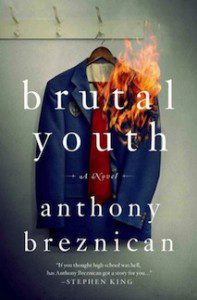
Anthony Breznican’s debut novel, Brutal Youth, opens with a troubled teenaged boy, nicknamed “Clink,” violently hurtling statues of saints off the roof of St. Michael’s, the crumbling Catholic school that sets the stage for all the drama within the book’s four hundred plus pages. Clink is far from a central character—we only see him once more, for a fleeting moment—but throughout Brutal Youth he is often referred to, and always as “The Boy on the Roof.” Consider the prologue a preview of heavy-handedness—no pun intended—to come.
Peter Davidek and Noah Stein are visiting students standing on the lawn below the shower of statues the day of the infamous “Boy on the Roof” incident, and they form an instant bond by trying to be heroes together. Fast-forward several months, and for tenuously believable reasons, both Davidek and Stein—as they are referred to throughout the book—have decided to enroll at St. Mike’s, and meet again on the first day of school. They immediately get a taste of how bad the year ahead will be. Unidentifiable muck slides down the school walls; seniors engage in vicious yearlong hazing, torturing freshmen while teachers turn a blind eye; and no one—not the heads of the school, not the guidance counselor, not even the only warm-hearted teacher—has even a scrap of sincere love for St. Michael’s, or for teaching. And certainly not for the students.
Could it get any worse?
Unfortunately, yes. And this is where the blurb on the cover of the book, from Stephen King, backfires. The Famous Writer’s endorsement leaves a one-upping door wide open: “If you thought high school was hell, has Anthony Breznican got a story for you…”
The chief trouble is this: the novel details a series of tragedies that befall Davidek, Stein, and a girl named Lorelei whom they befriend, and each episode (there are too many to count) trumps the last, without any further insight into the characters. It starts with Stein and Davidek’s banal detentions, then Lorelei being bullied by two sophomore sisters whose “surly attitudes… reflected lifetimes of torment” (there’s a blighting lack of graceful language throughout), and eventually leads to a relationship between Lorelei and Stein. As in many of the tangled plotlines, Lorelei and Stein’s relationship seems to be lifted from teen movies; she pairs with him because the two senior boys who have been “assigned” to torment her want to hurt Stein, and threaten her into agreeing to pretend to like him. Of course, we know where this goes. She actually falls in love with him. But then, in one of the most vexing parts of the book, she tells his biggest secret to the two seniors. The explanation offered up for her lapse in loyalty? “If [her] motive baffled her, maybe she didn’t want to know the real reason. Easier to believe it simply made no sense.”

The rest of the book rests on the decision she makes in this moment, and yet we are never offered a further glimpse into her impulsive disloyalty. Apparently, one sentence stating that the motive baffles even her is meant to be enough for us.
Even the backstories of these characters aim to out-do each other: Davidek’s mother and father are heartless because his brother has disappeared; Lorelei’s mother is an alcoholic with a prosthetic arm, which she uses to beat her daughter; and Stein—well, Stein’s story will take too long to get into, so let’s just leave it at this: there’s quite a tale behind the scar on his face, and that’s in part how Lorelei ruins his life.
There is no introspection for the students of St. Michael’s. There are few gray areas in their stories. Seniors are on the whole evil, freshmen are for the most part scum, and amidst all the face-to-face combat, I found myself longing for the sorts of internal conflicts I experienced in my own adolescence.
The most tender moments in the book arise with the character of Hannah, an outcast who has saved herself from utter ridicule by instilling fear into her peers. She’s a senior, and supposedly she’s been keeping a book of secrets about everyone at St. Michael’s during her four years there (yet another teen movie plotline). Davidek serves as her freshman for Hazing Day, and he learns his fate early on: he’s going to have to read aloud on stage from Hannah’s book, dooming his popularity for the rest of his days at the school. Hazing Day looms large for many pages, but by the time it arrives, the rest of the plot is so muddled that the scene lacks real impact.
The premise at the heart of Brutal Youth could be strong, and that’s in part what makes it so disappointing to read—and so fascinating to critique. I found myself wondering about its faults: should Breznican have tried writing it from one perspective, instead of nearly a dozen? As Donna Tartt said in a 2002 interview with the Guardian, this sort of symphonic narration is “widely thought to be the most difficult form.” If he’d stayed in the mind of one character, might he have succeeded in conveying real depth? And for that matter, he could have worked to make the voice more consistent. At times, the book reads like it’s meant to be told from a close third person, with the slang of the characters entering the language of the story (often clumsily: “[Davidek] had kissed a girl before, but only once…a girl he had crushed hard on throughout eighth grade.”) In other scenes, the narrator is omniscient, which makes for an overall off-putting combination.
Breznican’s day job is as a senior staff writer for Entertainment Weekly. This touching piece—about a handful of interactions he had with Philip Seymour Hoffman—shows he can tell a hell of a story, and with a strong voice. But while I read Brutal Youth, I found myself wondering more than once if anyone had made editorial suggestions to him—either large-scale or nitpicky. Breznican’s path from writing movie and book critiques to writing a novel—with its demands of careful scene creation, character development, and thoughtful plotting—is a rocky one.




